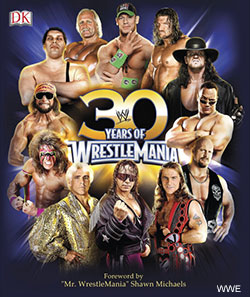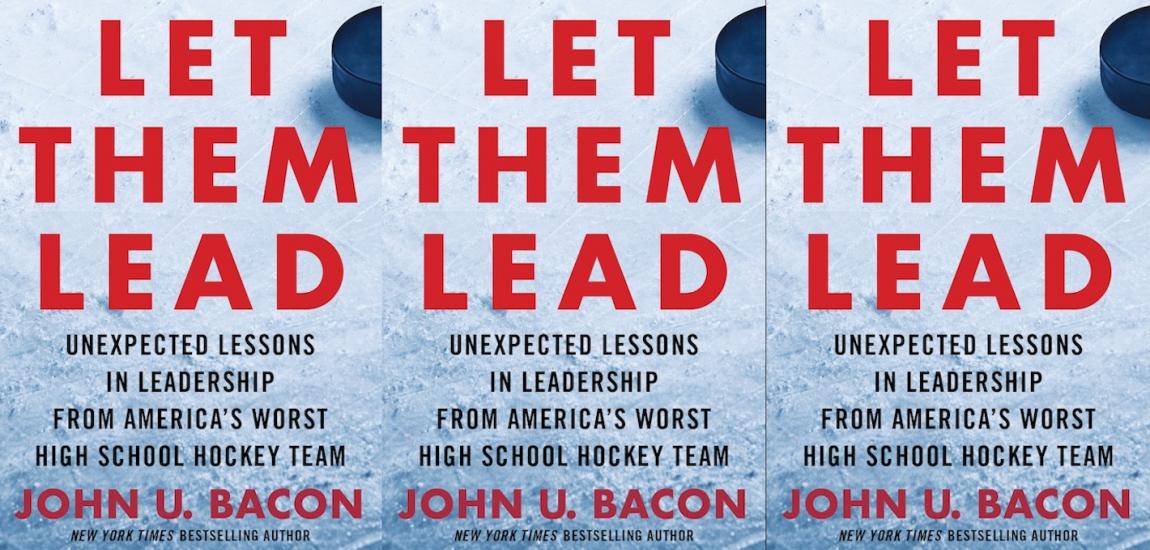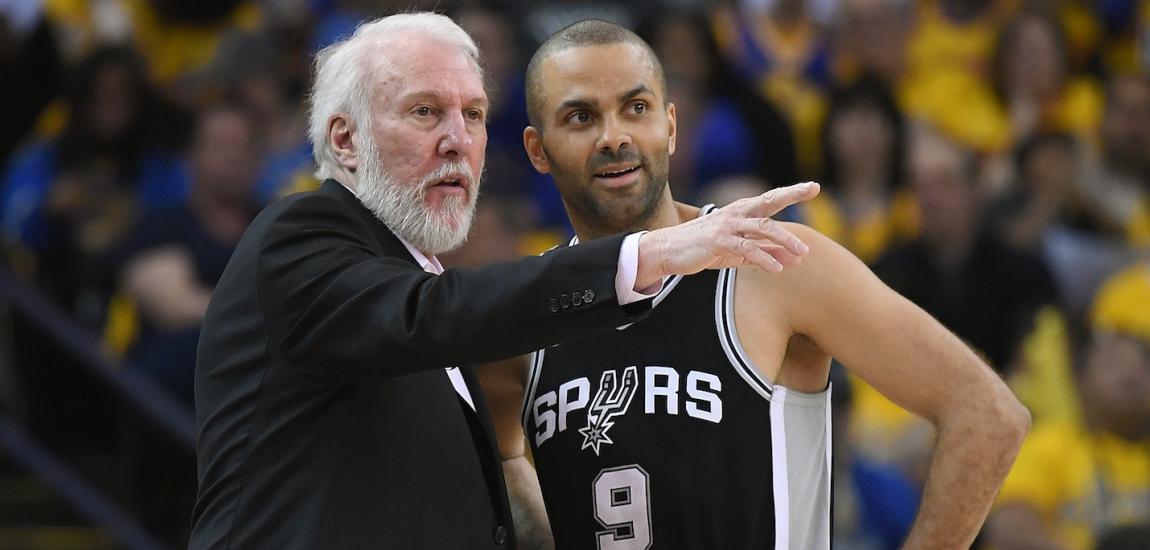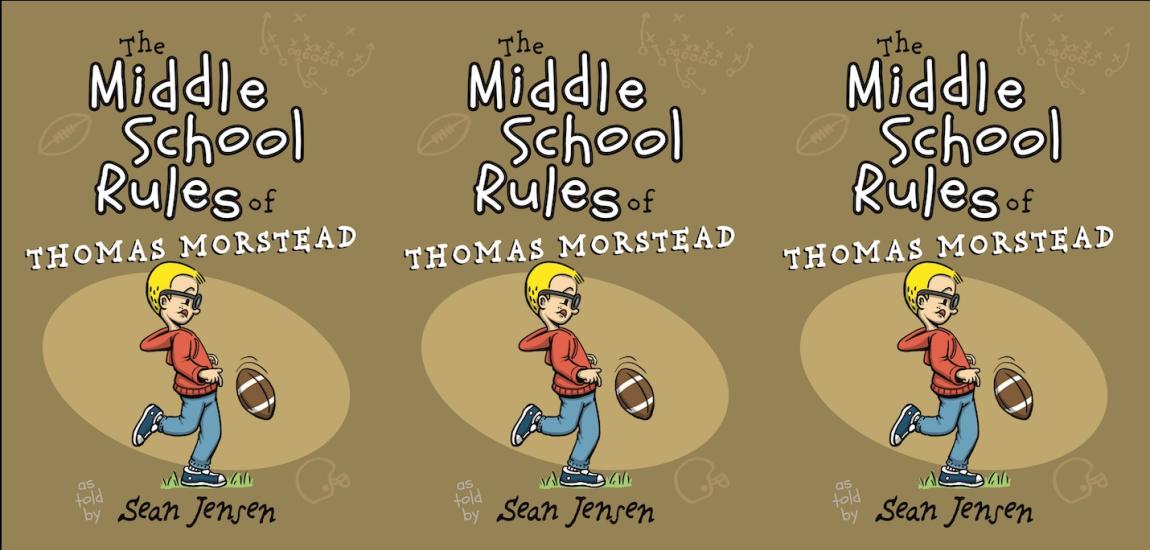WrestleMania III set the record for the largest attendance at a live indoor sporting event in North America. Held at the Pontiac Silverdome on March 29, 1987, this edition of WrestleMania drew 93,173 fans. The card had 12 matches that featured all-time greats such as Randy Savage, Ricky Steamboat, Roddy Piper, Bret Hart, Harley Race, Rick Martel and the Iron Sheik. The main event was the colossal clash between Andre The Giant and Hulk Hogan. 30 Years Of WrestleMania takes a closer look at how this historic night for the WWE was devised and developed.
In preliminary discussions for the third WrestleMania, Vince McMahon was adamant that WWE make the event a bigger, more grandiose production than WrestleMania 2. Given the success of the previous two events, for WWE the question was, "How do we make WrestleMania better?" The first step was returning WrestleMania to one location. Marketing was also key. During an early meeting to brainstorm taglines, the WWE team threw around different possible catchphrases until someone said, "This one's going to be bigger, it's going to be better, and it's going to be badder." Vince McMahon jumped from his chair and said, "Stop right there." He began to draw it in the air with his hand, "WrestleMania III: Bigger, Better, Badder."
The "Better" and "Badder" aspects were an accepted mission statement in a company that hosted live events 52 weeks a year. The "Bigger” component required additional work. WrestleMania sold out Madison Square Garden. WrestleMania 2 emanated from three locations and drew over 40,000 fans, along with hundreds of thousands more via closed-circuit. What could WWE do to make WrestleMania III "Bigger?"
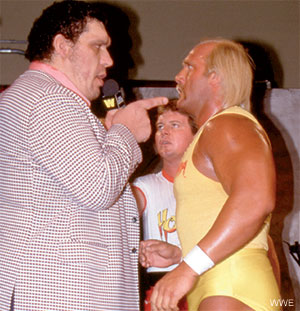
WWE wanted WrestleMania III to be as close to the east coast as possible. While WWE was a national company by then, their strongest fan base was in the eastern half of the United States. The Pontiac Silverdome was quickly selected as first choice. Ed Cohen remembers, "The phone rang at two in the morning. I was asleep, so my answering machine picked up. Vince started talking fast, saying, ‘Wake up! Ed, wake up!' I got on a plane to Michigan that morning with a check for $50,000 in my hand to hold the date for the Silverdome."
Selling 60,000 seats would have produced the largest crowd in WWE history, but the Silverdome could hold more than 90,000 spectators. To fill its seats, WWE needed the best talent combined with a breakthrough promotional campaign.
The Pontiac Silverdome could be configured for various seating arrangements. When asked which configuration he wanted to use, Vince McMahon replied, "The whole way, we are going to break the all-time indoor attendance record. It’s going to be over 90,000 people."
Hulk Hogan added, "Haven't you heard who's in the main event, brother?"
WrestleMania III rested on the public's connection with Hulk Hogan and Andre the Giant. Crossing into 1987, Hogan became a household name and the industry’s most recognizable ambassador.

Throughout his career, Andre the Giant was the greatest attraction the industry had ever known. But heading into the mid-1980s, Andre’s body started to suffer the rigors of the business. He felt it was time to wind down his in-ring career. For WrestleMania III to fulfill its mission, Andre would have to agree to participate. Vince McMahon remembers, “Right after WrestleMania 2, I flew to England to visit Andre. He was filming The Princess Bride. He was suffering from excruciating back pain and needed surgery. Originally, he wasn't going to have the surgery but I convinced him to have it and be a part of this one last thing. I told him, 'You and Hogan will draw the biggest crowd ever for an event like this.' And he agreed."
To account for Andre's post-surgery absence, WWE issued a statement saying that he had been suspended for not fulfilling certain contractual obligations. Very few people knew at the time that Andre was recovering at the McMahon family home in Greenwich, Connecticut.
The buildup to WrestleMania III's main event started on the January 17, 1987, episode of Piper's Pit. Hogan and Andre received awards from then-WWE President Jack Tunney. Andre took the first step toward the historic encounter by leaving in the midst of Hogan’s acceptance speech. Roddy Piper remembers, "The Andre and Hogan segments were done in the Pit because WWE needed the three biggest properties -- Andre, Hogan, and Piper -- together to get the storyline over with the fans. I needed the crowd to focus because this was serious."
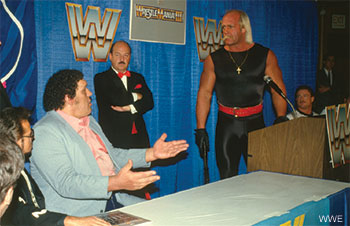
Over the next two weeks, WWE personalities who had credibility with the audience as "knowing" Andre speculated on his uncharacteristic behavior. On February 7, the Piper’s Pit audience gasped when Andre appeared with Bobby "The Brain" Heenan. Staring at Hulk Hogan, Andre challenged the Hulkster to a match at WrestleMania III. To dramatize Andre's transformation to a life of evil, he tore off Hogan's shirt and cross, and blood ran down the WWE Champion's chest. The segment ended with Piper consoling Hogan in one of sports-entertainment television's most memorable moments.
Turning Andre into a villain created the ultimate showdown and maximized WrestleMania III's drawing power.
It took Hulk and Andre a long time to reach a point of mutual friendship and respect. Hulk Hogan recalls, "I'd be on the way to the building, knowing I had to wrestle [Andre], and I was so scared that I would pull the car over and vomit." However, Andre gained respect for Hogan in Japan. Hogan faced a tough situation with a wrestler named Tatsumi Fujinami who would have seriously injured Hogan if he could. When the Hulkster claimed the victory despite the challenging circumstances, Andre saw the skill Hogan displayed in the ring. Hogan said of his relationship with Andre, “I think, after that night, things changed."
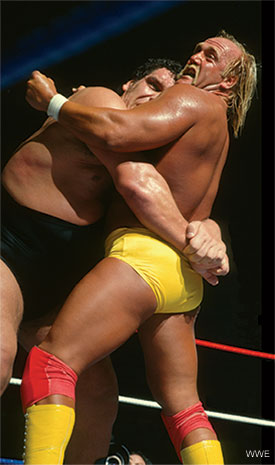
Despite the collaboration the main event required from Hulk Hogan and Andre the Giant, there was uncertainty up until the last minute. It was crucial that Andre allow two things: the bodyslam and the ultimate defeat. Vince McMahon reflects, "It's funny because Hogan was scared to death. Hogan had been in the ring with [Andre] before, but not like this. Andre had this habit with anyone of consequence as far as size was concerned; he had to show them who was boss. [Hogan] wasn’t too sure if the result would come out like he thought it would. I knew what Andre was going to do; Hogan knew what Andre could do. Big difference."
Hulk Hogan entered the Silverdome to the deafening roar of his Hulkamaniacs. The Hulkster and Andre the Giant traded displays of power and dominance, each move eliciting outcries from the record crowd. Then Hulk Hogan performed the unimaginable. He slammed "The Eighth Wonder of the World" and pinned him with his famous Leg Drop. In the act of defeat, Andre the Giant showed his love for the business that made him an icon. McMahon recalls, “That was the highest moment that Andre would ever have in the business. He was so proud of that. Even in his later days, when he could hardly move in the ring, he lived off of that, and he should have."
WrestleMania III sold more tickets than the Super Bowl, and WWE was now the undisputed owner of the indoor attendance record. As the show came to a close, WWE, Hulk Hogan, and Andre the Giant crossed the threshold of entertainment immortality together.
-- Excerpted by permission from 30 Years Of WrestleMania by Brian Shields and Dean Miller. Copyright (c) 2014 by WWE and DK/BradyGames, a division of Penguin Group (USA). Published by DK BradyGames. All rights reserved. No part of this excerpt may be reproduced or reprinted without permission in writing from the publisher. Available for purchase from the publisher, Amazon, Barnes & Noble and iTunes. Follow Brian Shields on Twitter @ItsBrianShields.

